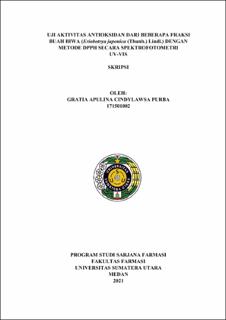Uji Aktivitas Antioksidan dari Beberapa Fraksi Buah Biwa (Eriobotrya japonica (Thunb.) Lindl.) dengan Metode DPPH Secara Spektrofotometri UV-VIS
Antioxidant Activity Test of Some Loquat (Eriobotrya japonica (Thunb.) Lindl.) Fractions Using DPPH Method by Spectrophotometry UV-VIS

Date
2021Author
Purba, Gratia Apulina Cindylawsa
Advisor(s)
Masfria
Wahyuni, Henny Sri
Metadata
Show full item recordAbstract
Background: Loquat (Eriobotrya japonica (Thunb.) Lindl.) has high nutritional
value besides the leaves and seeds contain medicinal properties. Loquat contains
malic acid, tartaric acid, citric acid, carotene, vitamin A, vitamin B, and vitamin C
which are secondary metabolites that can inhibit oxidation reactions.
Objective: The purpose of this study to examine the antioxidant activity of several
fractions of loquat.
Method: Testing the antioxidant activity of loquat using the DPPH (2,2-diphenyl-
1-picrylhydrazil) method by UV-VIS spectrophotometry.
Results: The results of the antioxidant activity test using the DPPH method (2,2-
diphenyl-1-picrylhydrazil) showed that the ethyl acetate fraction of loquat had
strong antioxidant activity with an IC50 value of 68.3371 μg/mL, followed by a
weak category of n-hexane fraction with IC50 value is 170.2165 μg/mL, and the
remaining fraction is very weak category with IC50 value of 351.9575 μg/mL, as a
positive comparison is vitamin C with IC50 value of 1.4 μg/mL.
Conclusion: The results showed that the ethyl acetate fraction of loquat had the
strongest antioxidant activity using the DPPH method and significantly different
from n-hexane fraction and residual fraction (p < 0.05).
Collections
- Undergraduate Theses [1834]
